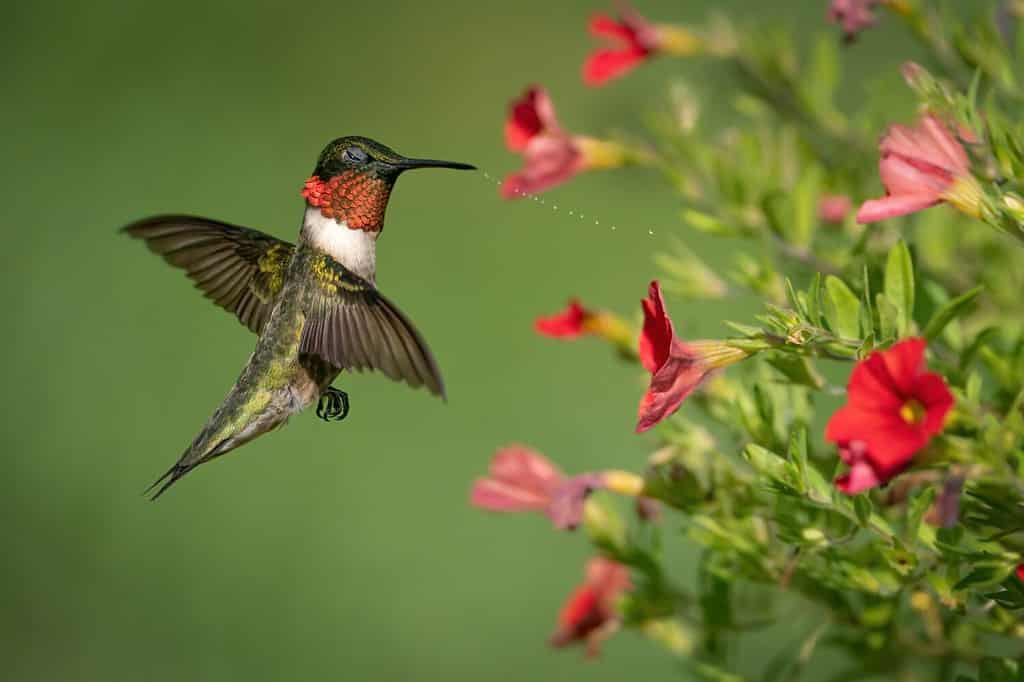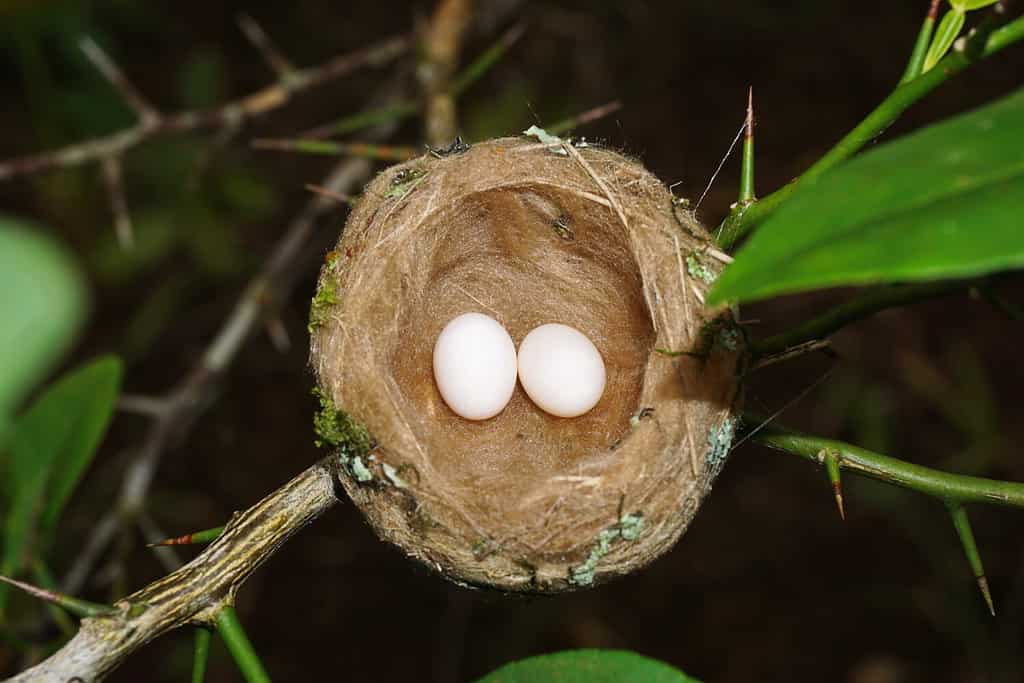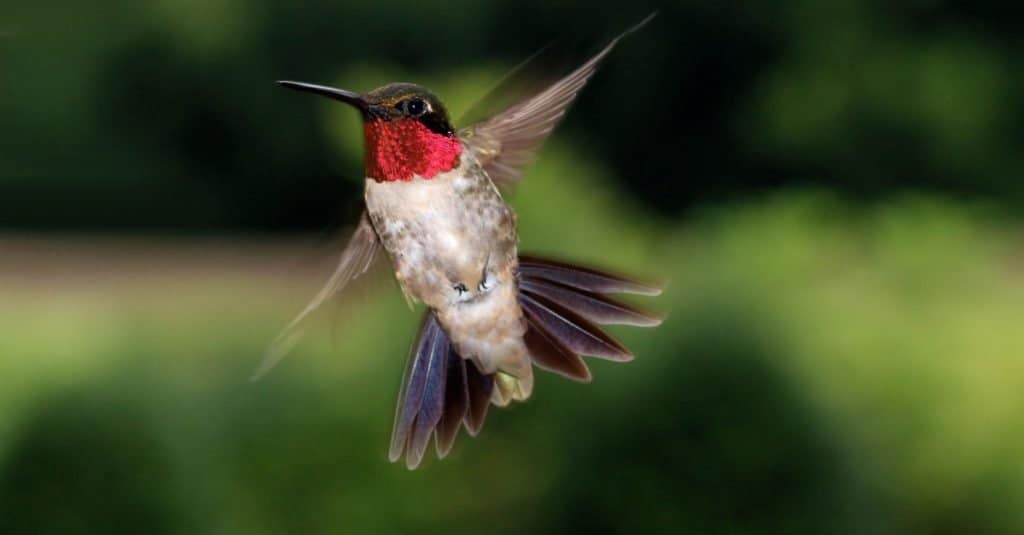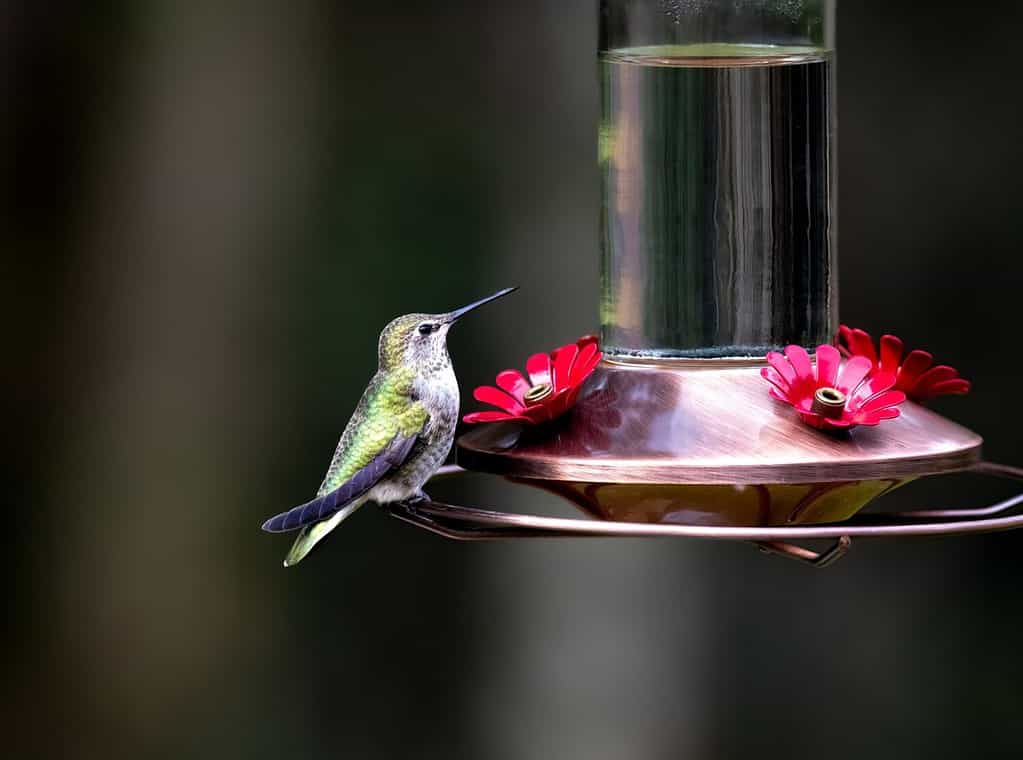Welcome to our blog post on the fascinating departure of hummingbirds from Minnesota. As we delve deeper into this topic, we aim to shed light on the exact timing and reasons behind these tiny birds’ migration patterns. Join us as we explore when and why hummingbirds bid their farewell, leaving our state in awe every year.
Types of Hummingbirds in Minnesota
Minnesota is a fascinating destination for bird enthusiasts, particularly those captivated by the captivating allure of hummingbirds. Among the various species that gracefully traverse the skies during their annual migration, one stands out as the main protagonist in Minnesota. The ruby-throated hummingbird! While there are a handful of other types that may accidentally or sporadically grace Minnesota with their presence, these occurrences remain few and far between.
Ruby-Throated Hummingbird Appearance

©Cavan-Images/Shutterstock.com
The ruby-throated hummingbird is a small bird with a bright emerald-green back. It has a white underside with a few green stripes. Its throat is a bright ruby-red, and its bill is black. Its wings are glossy black, and its legs are short and gray. The ruby-throated hummingbird has a tiny body with a round head, a short tail, and a short, straight, thin beak. Its eyes are black, and its feet are small and gray. On average, the ruby-throated hummingbird measures about 3.5 inches in length and weighs about 3.4 grams.
When Do Hummingbirds Leave Minnesota?
Our hummingbirds are known for their preference for warm weather. Some other species of birds that tough it out during the chilly winter months in Minnesota. But these tiny wonders choose to spend their winters in the tropical regions of Central America.
As we eagerly await their return each year, it is worth noting that the first week of May usually marks an exciting milestone for hummingbird enthusiasts in Minnesota. May is when the first migratory hummingbirds typically make their appearance in the southern part of the state. It’s a moment cherished by many as they witness these small marvels making their way back after a long journey across thousands of miles.
Once they have arrived safely on our shores, these agile flyers waste no time getting down to business – breeding. In fact, they can be found nesting throughout not only Minnesota but also across vast stretches of the eastern United States and even into central and eastern Canada. Their adaptability knows no bounds as they successfully establish themselves in various habitats within this wide range.
However, just as swiftly as they arrive and settle into their summer homes, our beloved hummingbirds start preparing for another great migration come mid-August. With autumn approaching and cooler temperatures creeping in, these tiny aerial acrobats bid farewell to Minnesota and begin embarking on their remarkable journey southwards.
By the end of September – which often serves as nature’s cue signaling an imminent change in season – most hummingbirds have started the journey southward.
Habitat

©Damsea/Shutterstock.com
Hummingbirds nest in open spaces, such as gardens, orchards, and even your very own backyard. The thicker forested areas also play a crucial role in serving as a habitat for ruby-throated hummingbirds. These petite creatures can thrive as long as there are trees available within their environment. We commonly witness hummingbirds gracefully flitting about, indulging in the sweet nectar of flowers, or visiting specially designed feeders. They rely on the denser cover when seeking shelter for roosting. In fact, these remarkable birds construct their tiny and inconspicuous cup nests along the branches of both trees and taller shrubs.
Hummingbirds’ ability to adapt to various types of habitats showcases their remarkable versatility. They enjoy lush forests with towering trees and meticulously maintained gardens adorned with vibrant blooms. These feathered wonders have found ways to make themselves at home amidst diverse environments. However, one consistent factor remains the need for trees in order to provide suitable nesting sites. They also require nectar-rich plants nearby.
When choosing locations for building their delicate nests, hummingbirds display a preference for secure perches hidden within the foliage of larger plants. Did you know that their nests are no bigger than half of an eggshell? They usually select tree branches or taller shrubs and build nests 10-30 feet off the ground. This offers additional coverage from potential predators and inclement weather conditions alike. They use materials such as plant fibers, spider silk, and moss to make cozy nests for their babies.
Behavior

©Ramona Edwards/Shutterstock.com
Even though they are tiny, male ruby-throated hummingbirds possess an impressive and fierce nature when it comes to defending their territory. Despite being significantly smaller than some of their adversaries, these tiny birds are known to take on larger birds. They will even fight hawks in order to protect their space! Their determination is evident during courtship or chase flights. You will hear the characteristic humming sound produced by the rapid beating of their wings. But also high-pitched chips and squeaks that further emphasize their presence.
However, as fall approaches and it’s time for migration, these fiery tempers seem to mellow down a bit. During this period, many hummingbirds come together in large groups as they make preparations for their journey southward. This gathering serves two purposes. You will see them indulging in flower nectar and feasting on small insects. These offer essential nutrients needed for the long flight ahead. Most hummingbirds double their body fat in order to survive the long migration.
How to Attract Hummingbirds in Minnesota

©Jeff Westhead/Shutterstock.com
Attracting hummingbirds to your backyard in Minnesota can be a delightful experience. With a few simple steps, you can create an inviting haven for these enchanting creatures. One of the most effective ways to attract them is by planting tubular flowers. They require large amounts of nectar from flowers, such as cardinal flowers or bergamot. These native flowers are particularly enticing to ruby-throated hummingbirds – their vibrant colors and nectar-rich blossoms act as irresistible magnets.
It is ideal to opt for flowers native to Minnesota. But, incorporating noninvasive garden flowers and cultivars into your yard can also prove successful in drawing hummingbirds. These varieties provide additional options for the birds and add diversity to your floral landscape. By offering a range of choices, you increase the likelihood of attracting different species of hummingbirds throughout the season.
In addition to planting the right flowers, setting up a hummingbird feeder can further enrich their presence in your backyard oasis. This supplementary food source acts as an irresistible beacon when strategically placed amidst your blooming flora. To prepare a nourishing solution for your feeder, simply mix one part granulated sugar with four parts water until fully dissolved. It’s crucial to change out or refill this liquid once every week. This is especially true during hot weather conditions when spoilage may occur more rapidly.
When selecting a feeder, consider those with red, orange, or pink accents. These mimic natural sources of nectar that hummingbirds are instinctively drawn towards. Bright colors serve as an alluring cue that guides them directly toward their sustenance. Do not add food coloring to the water. This is unnecessary, and some sources say it may be harmful in the long run.
10 Incredible Hummingbird Facts

©CounselorB/Shutterstock.com
- Hummingbirds are the smallest bird species in the world, with some species measuring just 2 inches in length.
- Hummingbirds are the only bird species that can fly both forwards and backward.
- Hummingbirds are able to fly at speeds of up to 30 miles per hour.
- Hummingbirds eat 2,000 insects per day when feeding their babies.
- Hummingbirds are able to hover in mid-air while feeding on nectar from flowers.
- Hummingbirds are able to drink up to 8 times their body weight in nectar each day.
- Hummingbirds have an incredibly long lifespan for their size, with some species living up to 12 years.
- Hummingbirds can migrate up to 3,000 miles each year.
- Hummingbirds are able to go into a hibernation-like state known as torpor in order to conserve energy.
- Hummingbirds have incredibly acute vision, with some species able to see ultraviolet light.
"bird" - Google News
August 06, 2023 at 07:37PM
https://ift.tt/uVhosle
Discover When Hummingbirds Leave Minnesota - AZ Animals
"bird" - Google News
https://ift.tt/0clqRNx
https://ift.tt/B0ujHGV
Bagikan Berita Ini















0 Response to "Discover When Hummingbirds Leave Minnesota - AZ Animals"
Post a Comment